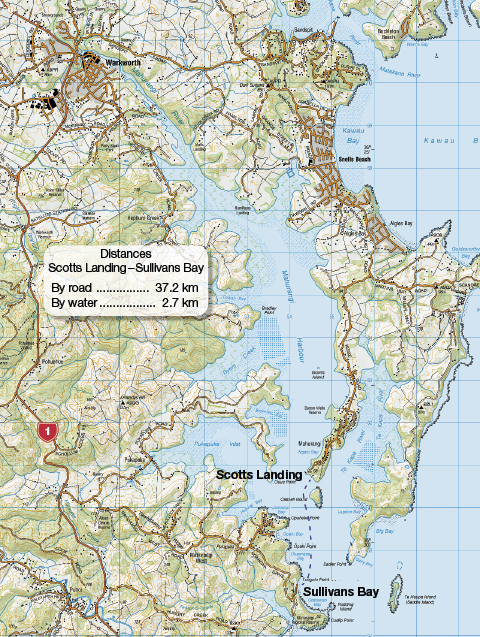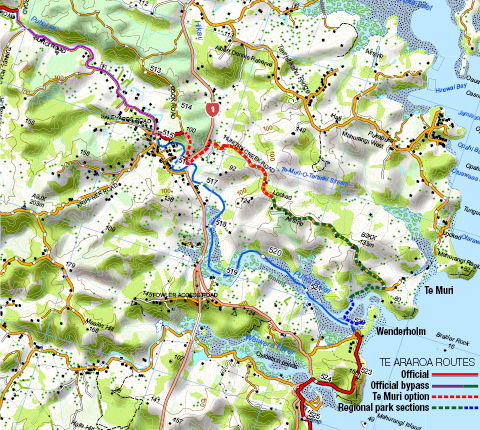Centreboarders, Sealegs and Scotts Landing logistics

Long and Winding: The sometimes tortuous and often congested 37 kilometres of road between Scotts Landing and Sullivans Bay contrast with the just 2.7-kilometre voyage by water. map Land Information New Zealand Labels Mahurangi Magazine
It is currently kinder for folk with sleep-aboard craft.
That is, the Mahurangi Regatta in its current format, than for those whose craft weren’t primarily designed with a good night’s sleep in mind.
If, after launching at Sullivans Bay and sailing in the regatta, the crew of a sailing dinghy decides to attend the prize-giving dance at Scotts Landing, the drive around the harbour can take nearly an hour. Just exiting Mahurangi West Road to turn northward onto State Highway 1 can take an eternity in holiday weekend traffic, and is additionally fraught if trailing an extra four or five metres of lovingly restored and irreplaceable maritime heritage.
A long-term goal of the Mahurangi Action Plan is for a jetty to be established at Mahurangi West. This will allow a cross-harbour ferry service to operate on regatta day, but it is essential to the fossil-fuel responsible development of the regional park network. Combined with the proposed Mahurangi Coastal Trail, some 900 hectares of parkland would be accessible by the metropolitan transport system, from its northern terminus at Waiwera.
The seemingly obvious option of simply sailing to Scotts Landing after the racing is complicated by the launching regime at Sullivans Bay. Other than on regatta day, only craft that can be manhandled in and out of the water can be launched or retrieved there—vehicle access is chained off. On regatta day, which since 1979 is the Saturday of Auckland Anniversary weekend, trailer launching and retrieval of craft associated with the regatta is performed by regional park rangers—launching 9–11 am; retrieval 3.30–4.30 pm.
There are, of course, places outside the park where boats can be launched or retrieved at all times, tide permitting. As luck would have it this year, the tides are entirely workable for Ōpahi and Jamieson Bay, being high at 07:37 and 19:45 hours. But Ōpahi is congested and trailer parking is at a premium, and Jamieson Bay has no trailer parking at all. Trailers can be parked on Jamieson Road, but it later involves a steep slog back up the right of way (which is specifically for the enjoyment of the public, despite lingering indications to the contrary).
Possibly the worst option is to attempt to attend the prize-giving dance by road, with that prized sailing dinghy in tow. There is very limited parking at Scotts Landing at the best of times, and on the afternoon of the regatta, finding a place to park a trailer anywhere near the landing would be diabolically difficult. The regional park at Scotts Landing is permanently closed to parking, aside from vehicles directly involved with events there, such as those bringing the Prohibition Big Band musicians, the sound and lighting technician, and St John.

Bussing to the Regatta: In time, the Mahurangi Coastal Trail will allow public transport savvy individuals to take the hour and a quarter walk to Sullivans Bay—an option that is currently only available at low tide. map Te Araroa Labels Mahurangi Magazine
The smart option—but fossil-fuel intensive, if residing to the south—is to arrive at Scotts Landing at dawn, or near after. That way the prized contestant is sailed at least part of the way to the regatta on her own bottom, as in days of yore and stipulated in the first revised America’s Cup deed of gift. Under this option, by the time the band begins playing background music at 6pm, the little ship can be snug back on her trailer. If the worst comes to the worst and she loses her prime parking spot in the process, the free regatta shuttle bus will whisk her crew back to the landing, particularly if it has earlier saved the contact cell phone number: +64 27 462 4872.
The fossil-fuel friendly option for those living south of Warkworth would be to leave the towing vehicle and trailer at Ōpahi, which is immediately north of the regional park boundary, or at Jamieson Bay. Slipping back across the harbour late Saturday night square before the wind and the full moon, threading between a thousand riding lights promises to be memorable indeed. The drawbacks of this romantic option are that Ōpahi will be crowded and Jamieson Bay has no trailer parking, which means leaving trailer, and probably vehicle, on Jamieson Road and facing the steep slog back up the right of way later in the evening. The right of way, as everybody concerned now earnestly appreciates, is specifically for the enjoyment of the public, despite certain lingering appearances to the contrary. On the evening of the day after, the diminutive gem of a bay is the scene of the weigh-in of the fiercely contested Ōpahi – Jamieson Bay fishing competition, which may appeal to some of those spending the weekend in the Mahurangi Harbour. A modest entry fee is necessary, but can be paid on the morning in either bay.
The 25-knot easterly forecast for Saturday is a reminder of why the after-match function is held at Scotts Landing. Sullivans Bay will likely be largely devoid of yachts, come the evening, as it will make for a far from comfortable anchorage after five days of easterlies. Traditionally, the entire regatta would have been conducted from Scotts Landing in such conditions. Today, however, the sheer number of people attending the picnic regatta precludes relocating to Scotts Landing, accept where forecast wind strength was such that Sullivans Bay would be all but deserted. This scenario played out in 2005 and proved to be logistically challenging. It was also far from universally popular, particularly as Sods Law saw the Saturday, but only the Saturday, gaining some respite in the easterly.
If the Mahurangi Regatta format is currently less friendly to sailing dinghies than to sleep-aboard craft, it is certainly not by design. Originally, centreboard dinghies featured strongly and the cash prizes offered to the winners of 1800s events were surprisingly generous. Once Mahurangi West has its first ever public jetty, a much more civilised regatta will be possible. In the recent past, for example, older residents of Jamieson Bay have enjoyed beach-to-beach transport courtesy of the odd oyster farmer prepared to ignore rules regarding what his barge was licensed to carry.
In 2014, thanks to an initiative by a long-term regatta enthusiast, a water taxi service will operate from Scotts Landing with particular emphasis on ferrying folk back to their yachts after the dance and, depending on the state of the tide will allow the rigid inflatables involved to show off their Sealegs patented amphibious technology to good effect. If a free water taxi service becomes part of the Mahurangi Regatta fabric, it might hasten the day when it extends to Mahurangi West. Free, of course, carries the expectation that users will donate generously to the costs of the event. Even with the generous support of Rodney Local Board, there is a nominal $4000 shortfall in funding.
Every opportunity to scare up donations needs to be taken.

Thank you for your organisation of the Mahurangi Regatta. It was a marvellous event. Despite the gusty winds, not ideal for a small sailing craft like mine (the Frostbite Corsair) it was a highly enjoyable day. The big band in the evening was a highlight. With the beautiful boats offshore, the plethora of tenders on the beach, and the setting sun, it was a memorable evening. The provision of barbecues for cooking dinner was also great. Thanks for the map and instructions, including the number of the shuttle.